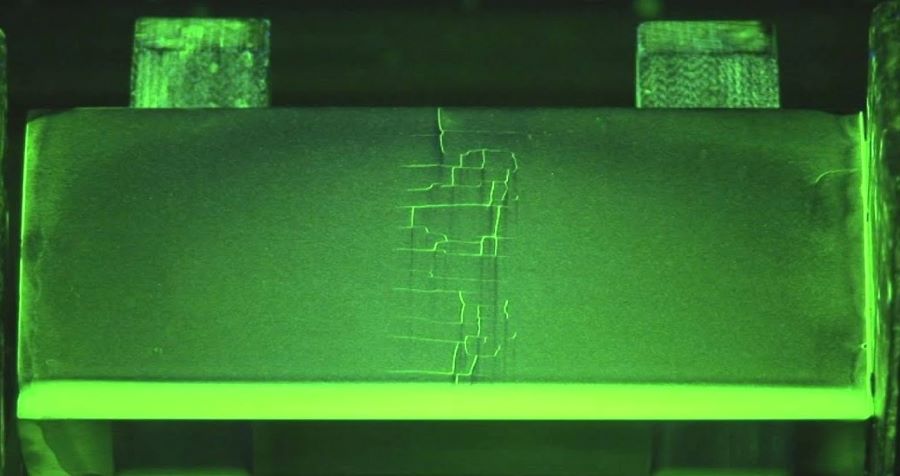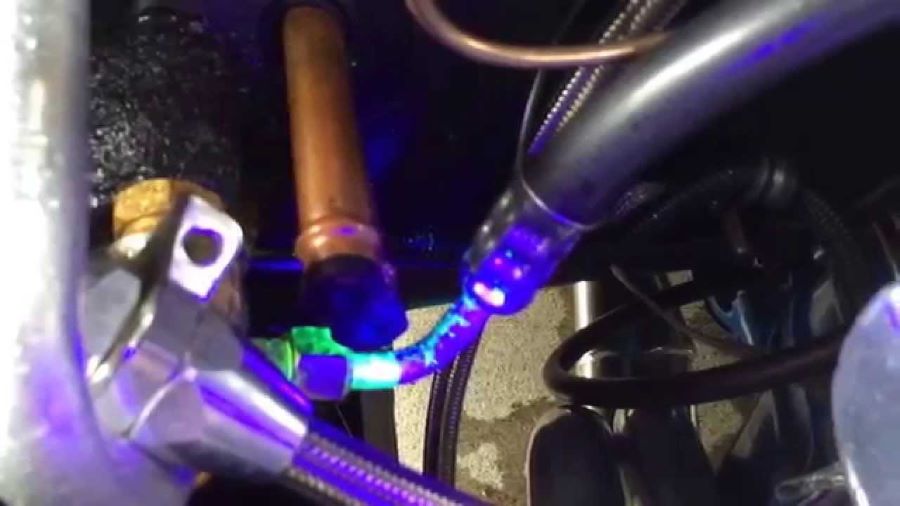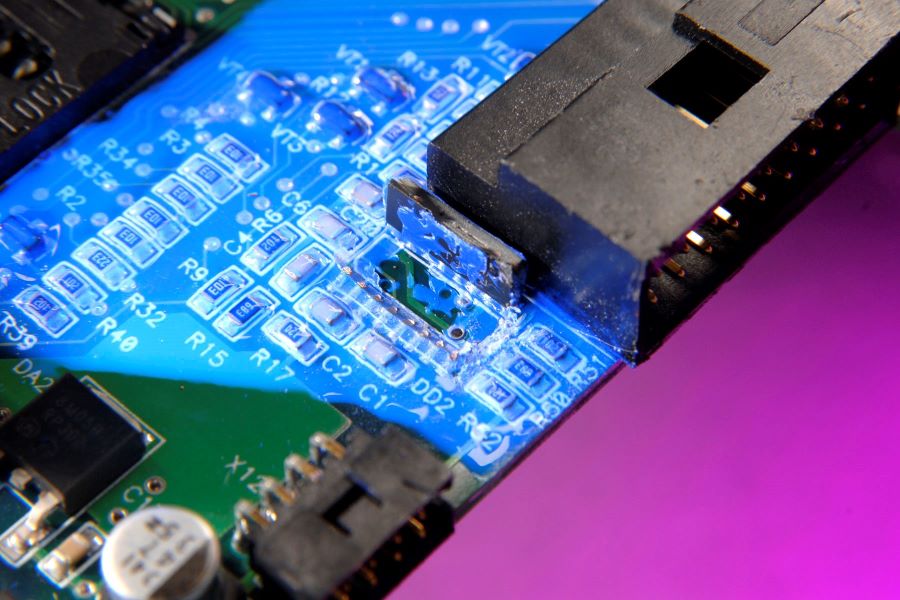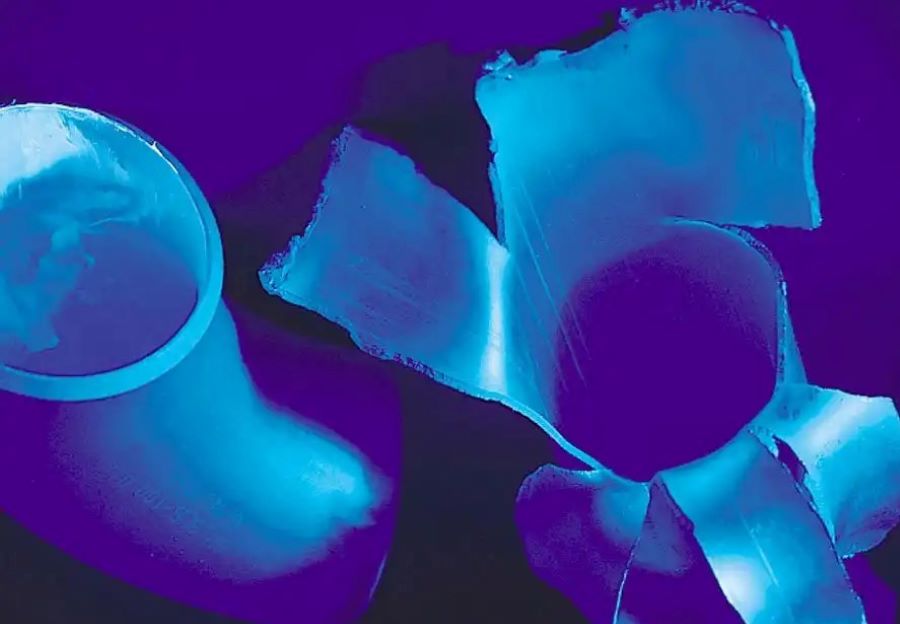一套荧光检漏套装解决工业设备泄漏
LUYOR-6801荧光检漏仪是美国路阳公司生产的荧光检漏仪套装,适用于检查小到中等规模的油基液体系...
2024-03-28作者:luyor时间:2020-06-19 08:37浏览1325 次
便携式黑光灯是在紫外线黑光下结合紫外线荧光材料或可见/不可见紫外线的颜料进行的。其中包括NDT裂纹检测;检测流体泄漏并验证材料扩散。在紫外线黑光下进行的紫外线荧光检查过程利用了材料的自然荧光特性。一个典型的例子是检测碳氢化合物的污染,例如氧气容器和连接管道中的油脂。
如今,行业比以往任何时候都需要不断开发和实施良好的质量控制程序。无论产品如何,质量和可靠性的重要性都是至关重要的。拒绝花费时间,金钱,并有可能破坏长期客户关系。因此,每次质量检查都必须正确。便携式紫外线黑光灯正在许多不同行业中迅速增加使用和接受,从而大大改善了质量控制。
紫外线的定义和分类
紫外线(UV)代表整个电磁光谱的一部分,从可见光的蓝色端(400 nm)延伸到X射线区域(100 nm)。
按照光能的增加顺序,将其细分为三个不同的波长区域,分别描述为UV-A,UV-B或UV-C。
UVA(400 nm – 315 nm):通常称为“黑光”,这是最长的波长区域和更低的能量,它代表了天然UV光的更大部分。大多数紫外线荧光检查过程都使用这种紫外线。
UVB(315 nm – 280 nm):比UV-A更高的能量,通常被称为中波或红斑紫外线。这部分被臭氧层阻挡,是自然紫外线的最侵蚀性成分,在很大程度上导致了晒伤(红斑)。
UVC(280 nm – 100 nm):比UV-A和UV-B高的能量。它通常被称为短波或杀菌紫外线。由于人造紫外线被地球大气完全吸收,因此通常仅在人造紫外线光源中遇到。
紫外线诱导的荧光的定义
紫外线光子提供的激发能比生理温度下吸收分子(例如紫外线荧光颜料)的热运动能高得多。因此,吸收分子暂时具有较高的能级。随着被激发的电子随后返回到较低的高能态,其多余的部分将作为光子发射被处置掉,从而产生荧光。与激发紫外线相比,荧光通常通过更长的波长来识别。
在质量控制荧光检查过程中使用紫外线黑光分为两个不同的类别:
紫外线荧光检查过程是在紫外线黑光下结合紫外线荧光材料或可见/不可见紫外线的颜料进行的。其中包括NDT裂纹检测;检测流体泄漏并验证材料扩散。
在紫外线黑光下进行的紫外线荧光检查过程利用了材料的自然荧光特性。一个典型的例子是检测碳氢化合物的污染,例如氧气容器和连接管道中的油脂。
用于检测裂纹的无损检测(NDT)
这也许是紫外线黑光荧光检测最广泛使用的应用。该过程依赖于通过紫外荧光磁性颗粒或染料渗透剂突出缺陷。这些可能是发际线裂缝,例如飞机起落架,汽车转向系统和我们赖以生存的许多其他关键部件。
与可选的色彩对比方法相比,此过程提供了更高的灵敏度。这是由于缺陷的明亮发光图像与黑暗环境之间的巨大反差,这确保了被检查表面的其余部分实际上消失了。结果更容易,检查更快。这些指示字面意义上是从操作员那里跳出来的,而不是相反的,检查员正在寻找缺陷或间断的视觉图像。结果是增加了发现缺陷的可能性。
该工艺最广泛地用于航空航天和汽车工业,在选择和操作UV黑光灯时必须小心以确保绝对符合所有相关标准。这些与UVA光辐照度的最小级别和更大允许可见光级别有关。

便携式黑光灯用于无损检测
流体泄漏检测
与NDT裂纹检测过程相似,因为它还依赖于颜色对比限定条件,因此灵敏度得到了类似的提高。将紫外线荧光泄漏检测添加剂与所涉及的流体系统混合,包括水,油,燃料,冷却剂和制冷剂。设备正常运行,以使荧光添加剂循环流通。然后,通过在紫外线黑光下检查所有外表面,管道,接头,线圈等,任何泄漏将显示为明亮的荧光黄绿色辉光。
此过程可用于常规质量控制或故障排除过程。典型的应用包括:-
汽车,包括发动机,变速箱,动力转向,液压,冷却和空调系统
空调和制冷设备
工业厂房及机械

便携式黑光灯用于液体荧光检漏
清漆材料分散验证
例如,电子印刷电路板上的透明涂层和金属被广泛用于保护和装饰目的。这些透明涂层通常是在配方中加入不可见/可暴露紫外线的颜料。在将涂料施涂到基材上后,紫外线黑光检查将确认保形涂料分散液的均匀性或选择性放置涂料的准确性。

便携式黑光灯用于pcb板三防漆涂敷检查
氧气清洁度验证,用于检测容器和连接管道中的碳氢化合物
最小量的碳氢化合物污染,例如氧气容器或连接管道内的油或油脂,将导致灾难性后果。它实际上是一种爆炸性混合物。
许多碳氢化合物会在紫外线黑光下自然发出荧光,因此,此过程对于所有氧气容器和工厂的制造商及用户都是绝对必要的。

便携式黑光灯用于氧气管道脱脂清洗检查
UV blacklight fluorescent inspection processes improve quality control
Today, industry has a great than ever need for continuous development and implementation of good quality control procedures.
The importance of quality and reliability, whatever the product, is paramount. Rejects cost time, money and have the potential to damage long term customer relationships. Therefore quality checks must be right first time, every time.
UV light fluorescent inspection processes are finding rapidly increasing use and acceptance across many different industries, resulting in dramatically improved quality control.
Definition and classification of UV light
Ultra Violet (UV) light represents a section of the overall electromagnetic spectrum of light, extending from the blue end of the visible (400 nm) to the x-ray region (100 nm).
It is subdivided into three distinct wavelength regions described as either UV-A, UV-B or UV-C in increasing order of photo energy.
UVA (400 nm – 315 nm): Often referred to as ‘blacklight’, this is the longest wavelength region and lowest energy, it represents the largest portion of natural UV light. It is this type of UV light which is utilised by most UV light fluorescent inspection processes.
UVB (315 nm – 280 nm): Higher energy than UV-A and often referred to as middlewave or erythemal UV light. Partially blocked by the ozone layer, this is the most aggressive component of natural UV light and largely responsible for sunburn (erythema).
UVC (280 nm – 100 nm): Higher energy than UV-A and UV-B. It is often referred to as shortwave or germicidal UV light. Only generally encountered from artificial UV light sources since it is totally absorbed by the earth’s atmosphere.
Definition of UV light-induced fluorescence
The excitation energy provided by UV light photons is much higher than the energy of thermal motion of the absorbing molecules e.g. UV fluorescent pigments at physiological temperatures. Consequently, the absorbing molecules temporarily assume higher energy levels. As an excited electron subsequently returns to a lower energetic state, its excess is disposed of as a photon emission, resulting in fluorescence. Fluorescent light is recognised by its usually longer wavelength compared with the exciting UV light.
The use of UV blacklight for quality control fluorescent inspection processes are split into two distinct categories:
UV Fluorescent Inspection processes performed under UV blacklight in conjunction with UV fluorescent materials or invisible/UV revealing pigments incorporated. These include NDT crack detection; detection of fluid leaks and material dispersion validation.
UV Fluorescent Inspection processes carried out under UV blacklight which utilises the natural fluorescent properties of materials. A typical example is the detection of hydrocarbon contamination such as oil and grease in oxygen vessels and connecting pipework.
Non-destructive testing (NDT) for the detection of cracks
This is perhaps the most widely used application of UV blacklight fluorescent inspection. The process relies on highlighting defects by UV fluorescent magnetic particles or dye penetrants. These can be hairline cracks for example in aircraft landing gear, automotive steering systems and many other critical components upon which our lives may depend.
This process offers greater sensitivity in comparison to alternative colour contrast methods. This is due to the dramatic contrast between the bright glowing image of a defect and the darkened environment, which ensures the virtual disappearance of the remainder of the surface under inspection. The result is easier, more rapid inspection. The indications literally jump out at the operator, rather than the opposite, where the inspector is seeking the visual image of the defect or discontinuity. The result is an increased probability of detection of defects.
The process is most widely used in the aerospace and automotive industries, where care must be taken when selecting and operating UV blacklights to ensure absolute conformance to all relevant standards. These relate to minimum levels of UVA light irradiance and maximum permissible visible light levels.
Fluid leak detection
Similar to the NDT crack detection process because it also relies on colour contrast qualifications and therefore offers similar sensitivity improvements. A UV fluorescent leak detection additive is mixed with the fluid system in question, including water, oils, fuels, coolants and refrigerants. The equipment is operated as normal to allow the fluorescent additive to circulate throughout. Then, by inspection under UV blacklight of all external surfaces, pipework, joints, coils etc, any leak will be revealed as a bright fluorescent yellow-green glow.
This process can be used for routine quality control or troubleshooting procedures. Typical applications include:-
Automotive, including engines, transmissions, power steering, hydraulic, cooling and air conditioning systems
Air conditioning and refrigeration equipment
Industrial plant and machinery
Clearcoat material dispersion validation
Clear coatings on electronic printed circuit boards and metals, for example, are widely used for protective and decorative purposes. These clear coats are often formulated with the inclusion of an invisible/UV revealing pigment. After application of the coating to the substrate, UV blacklight inspection will confirm the uniformity of conformal coating dispersion or accuracy of selective placement of coating material.
Oxygen cleanliness validation for detection of hydrocarbons in vessels and connecting pipework
The smallest amount of hydrocarbon contamination, such as oil or grease within an oxygen vessel or connecting pipework will result in catastrophic consequences. It is literally an explosive mixture.
Many hydrocarbons will naturally fluoresce under UV blacklight and therefore this process is absolutely essential for all oxygen vessel and plant manufacturers and users.